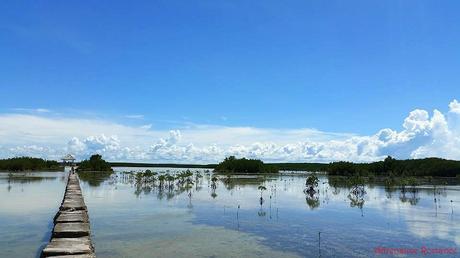
If you take a look at a world map, you will quickly realize the Philippines is in a strategic location. It serves as a waypoint, an entry point, an exit point, and a pit stop to the rest of mainland Asia. It is not difficult to understand then why several countries in the past spilled blood to conquer our country in. Whoever takes control of the Philippines will have a tactical geographical, military, and economic advantage over others.
That is the humanity’s perspective. Mother Nature, on the other hand, has another use for the Philippines’ strategic location. Being situated squarely near the equator, surrounded by vast seas, and blessed with rich marine resources, the country is a perfect midpoint for migratory birds that seek refuge from the harsh winters in the northern and southern hemispheres.
Most of these birds head to Olango Island at the very center of the Visayas. The island has some of the most extensive mangrove forests in the Cebu province and is endowed with rich coral reefs, expansive coralline sandflats, and huge seagrass beds. In addition, the flat island is sheltered from trade winds and monsoons.
This combination of factors makes Olango Island one of the 7 best-known flyways on Earth for migrating birds. Last November 23, we gathered a few friends—Jody, Em, and Jerrold—together with Alexa to join us for an educational tour in the Olango Island Wildlife Sanctuary, which was declared a protected area in May 1992 by President Corazon Aquino.
At 8:00 AM, we were already at the Punta Engaño port to board a boat to Olango Island. Check out how clean and organized the new terminal is. Aside from the usual administrative facilities, they have a nice souvenir booth and a small canteen.
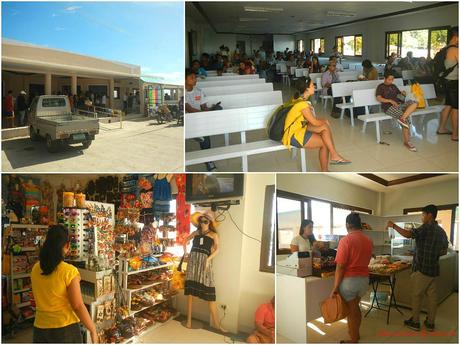
A little more than 30 minutes later, we heard the announcement that our boat is ready for boarding. Large pump boats like the one in the photo below regularly ferry passengers from Mactan Island to Olango Island and vice versa. Cars and trucks can also be ferried across the Hilutungan channel, but they are carried on a large barge.
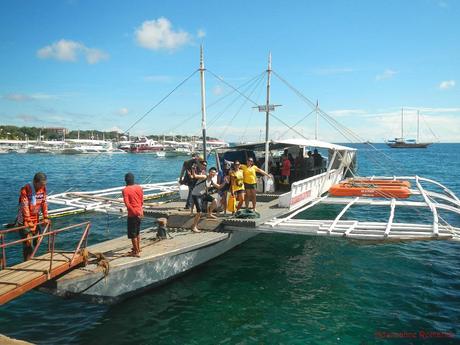
Heave ho! Slowly and surely, these deckhands carefully carried a motorcycle to the boat. Good thing though that the gangplank has railings. Or else, one wrong move can send the vehicle—and the humans carrying it—careening over the edge with disastrous consequences.
Yes, you can bring your motorcycle or bicycle along to Olango Island.
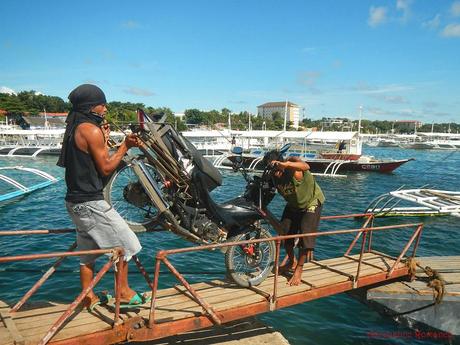
Lots of pump boats are available for tourists who want to go island hopping around Hilutungan Chanel. There are also pump boats that cruise from Mactan Island to Bohol.
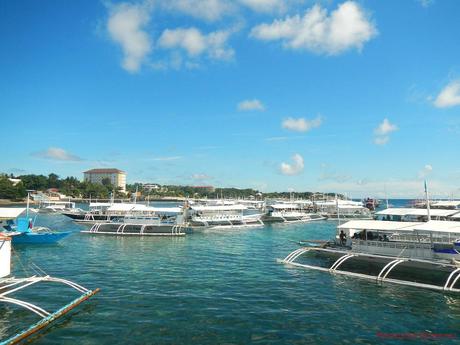
Fifteen minutes after 9:00 AM, our boat slowly de-ported; we were finally leaving after a relatively long wait. Goodbye, Mactan! We’ll see you again in a few hours.
By the way, those three hotel towers form the Movenpick Hotels and Resorts complex. The Swiss company recently bought the property from Hilton Hotels.
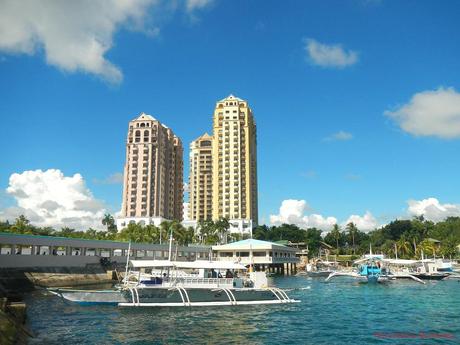
What a great sunny day for a relaxing cruise! The sea was quite calm, and there was a gentle breeze blowing from the northeast.
That’s our destination, Olango Island, at the horizon.
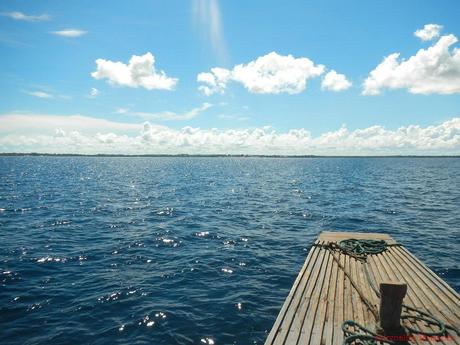
After a relatively smooth boat ride, we arrived at the port of Olango Island half an hour later. Everyone was excited to be back on land and to truly start this adventure.
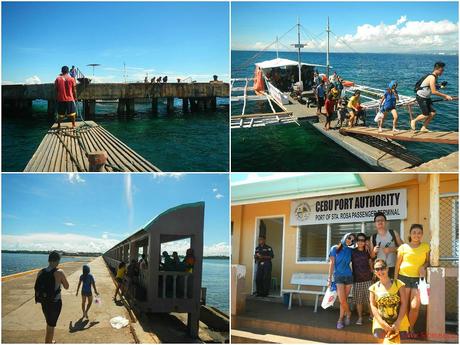
We negotiated a fair deal with a tricycle driver to take us to the bird sanctuary and fetch us back at around 3:00 PM. Once the fare was agreed upon, the driver whisked us to traverse what must be perhaps the longest pier in the world, which is nearly a mile long! You see, Olango Island’s continental shelf reaches far out into the Hilutungan Channel. Thus, a long pier was built towards an area which is deep enough for boats to dock without being at risk of running aground.
We bought packed lunch from a nearby carenderia before proceeding to the sanctuary.
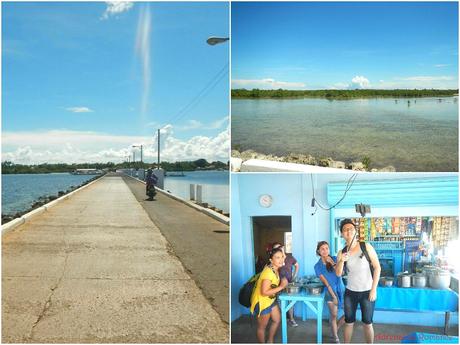
After buying hot food and cold drinks, we headed south towards barangay San Vicente where the sanctuary is located. Along the way, we were treated to breathtaking scenes of clean streams, virgin mangroves, coconut groves, and simple village life. What a beautiful island!
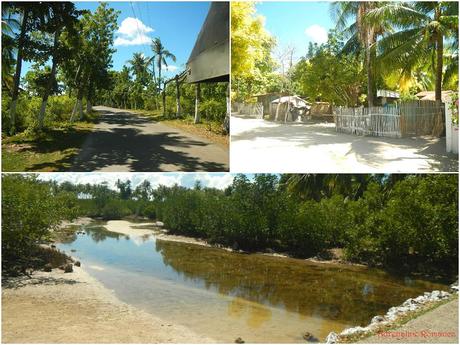
Even though Olango Island is just a quarter of the size of its neighbor Mactan Island, it took us quite awhile to reach San Vincente. But, after almost 30 minutes, here we were, at last!
Check out the nicely paved road. It encircles the entire island; bikers usually pedal down this circumferential road.
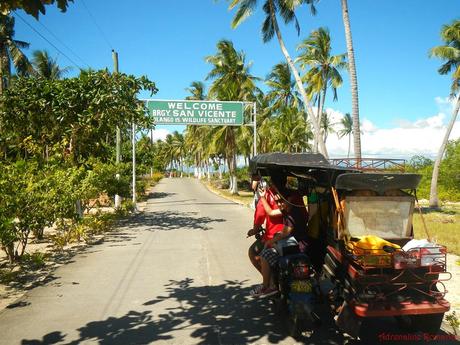
Nearing the sanctuary, we stopped by this shady tunnel of trees. This is actually a huge, full-grown, protected, and successful reforestation project conducted by the DENR. Kudos!

Finally, we arrived at our destination—the Olango Island Wildlife Sanctuary. Check out the immaculate and pristine condition of the place. Awesome!

Let’s go inside, shall we? The Nature Center was under renovation when we got there. When I first visited here a few years ago, this structure was made of wood, which is quite vulnerable to rot, decay, and damage. It’s about time that the OIWC Nature Center gets its makeover.
When the Nature Center’s renovation is completed, it will house an office, a small biological museum, a library, a laboratory and research center, and a storeroom.
The grassy areas are campgrounds where you can pitch a tent if you want to stay overnight.

A registration and entrance fee are required; the proceeds will be used to fund the maintenance of the sanctuary. Extra fees are collected for those who want to camp, use the center’s facilities, or do a commercial photoshoot in the sanctuary.
It was almost noontime by the time we reached the sanctuary, so we went to a vacant tent where we took our lunch.
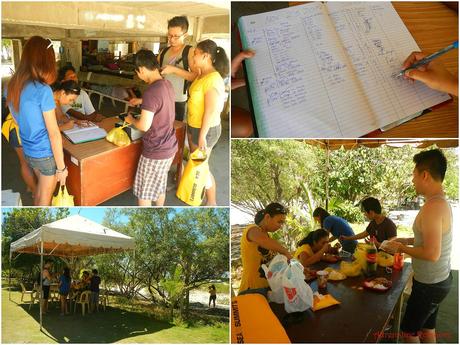
Immediately to the right side of the Nature Center is this vast mudflat. It is very rich in crabs, worms, and mollusks, which fall prey to birds, fish, and other animals.
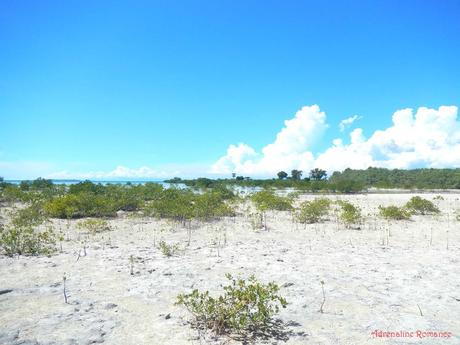
Hiding in a shady grove at the border of the sand flat was this magnificent but nervous night heron. They got their namesake from being a nocturnal ambush hunter. Night herons eat small mammals, aquatic insects, crabs, frogs, and fish.
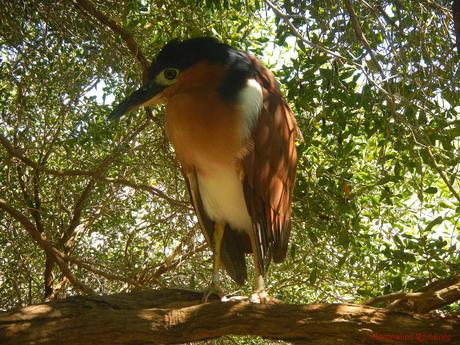
Indigenous trees and other foliage are labeled for proper identification.
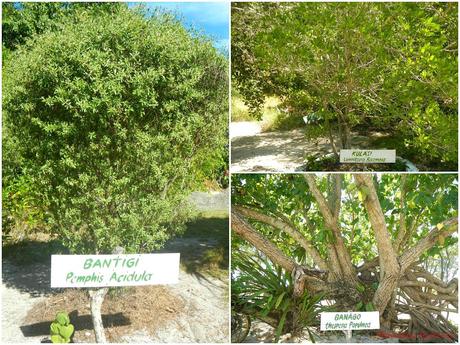
After eating our hot lunch and properly disposing of our garbage, it was time to head out into the main sanctuary. Check out the pathway; it is bordered by buried beer and softdrink bottles! What a creative way to recycle!
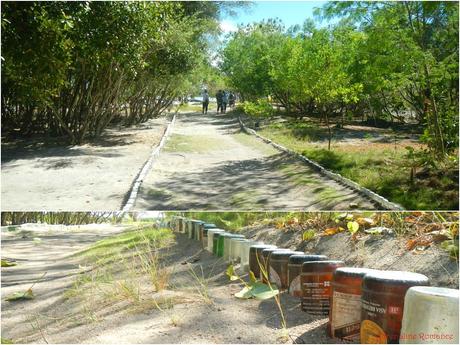
These tall trees provided scant protection against the bright, burning sun which shone at its full power in the almost cloudless midday sky. During high tide, this pathway gets submerged in water.
These trees must be really resilient to survive the combined onslaught of salt water, extreme heat, and rocky, sandy soil.

Welcome to the main sanctuary! A long pathway of concrete platforms cuts across the coralline sand flats. These sand flats are home to millions of crustaceans, fish, worms, mollusks, shellfish, starfish, and other creatures that become nutritious and healthy food for seabirds visiting the sanctuary.
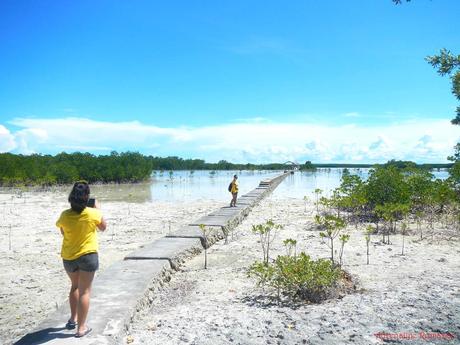
The sanctuary also has immense seagrass beds, which provide hiding places for marine creatures. Also, check out the baby mangroves, which are either naturally grown or transplanted by the caretakers.
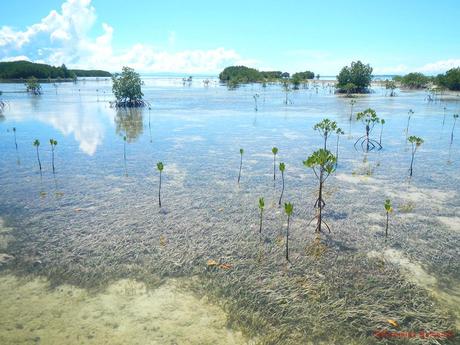
The photo below shows just a fraction of the entire sanctuary. Enormous, isn’t it?
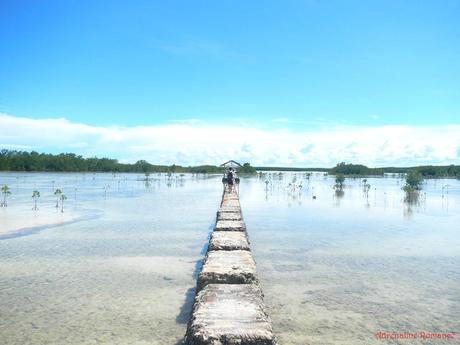
Halfway down the cemented pathway, we stopped by this small shed to find relief from the burning noontime sun.
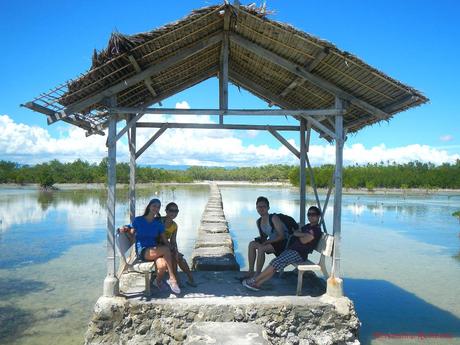
Here’s a glimpse of live bird food! There were hundreds and thousands of fish seeking shelter between the nooks and crannies of the pathway. Those who are lucky enough not to end as bird food soon leave the sanctuary and head out into the sea to spawn.
It is illegal to fish here.

While many areas in the sanctuary consist of transplanted mangroves, the patches of mangroves in the photo below grew naturally on the sand flats.
As we continued down the path, we were amazed at just how big and well-protected this sanctuary is. It is amazing to know that birds from as far as Japan, Northern China, and Sibera fly here to refuel before continuing their flight south.
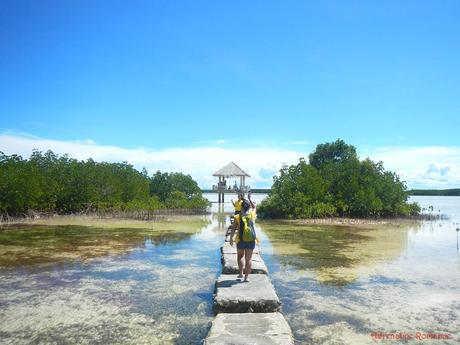
Finally, we arrived at the OIWC’s dilapidated but still functional observation deck. Don’t litter, and don’t make loud noises when you reach this area to avoid scaring off the birds.
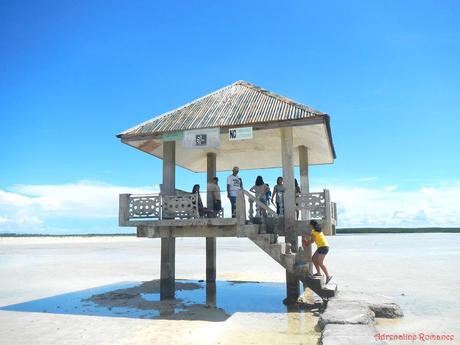
Look at that immense sand flat! That is the main feeding area of both migratory and resident birds. See those specks in the foreground? Those are actually migratory birds hunting for their lunch!
The green “hill” in the foreground is a fully grown man-made mangrove forest which acts as a breakwater, protecting the feeding ground from strong water currents.
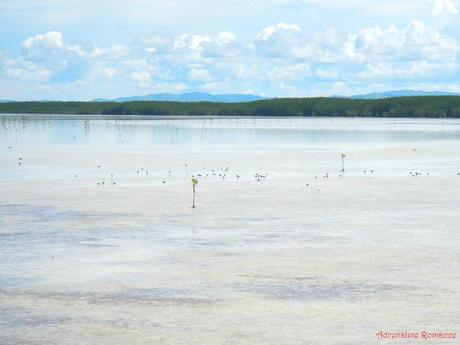
That’s the north side of the main feeding ground. The sanctuary extends way towards that green wooded area in the horizon.
The entire Olango Island Wildlife Sanctuary has an area of 920 hectares. That’s a huge buffet table for visiting and resident avians!
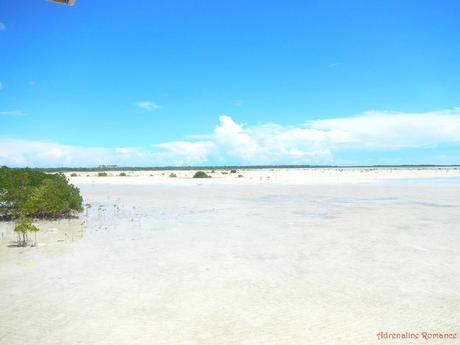
Those faraway green woods and that coconut grove are the bird’s roosting areas—places where they can rest and sleep—and nesting grounds.
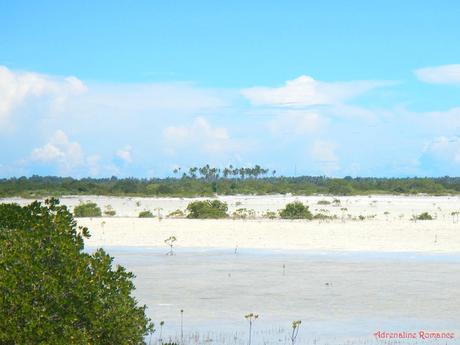
These natural grown mangroves provide shelter not only for fish and marine creatures but also for other birds. You see, predatory avians such as kites, hawks, and falcons also visit the sanctuary, feeding on other birds. These mangroves act as safety nets that offer protection for smaller birds from becoming victims in the sharp talons and wicked beaks of predators.
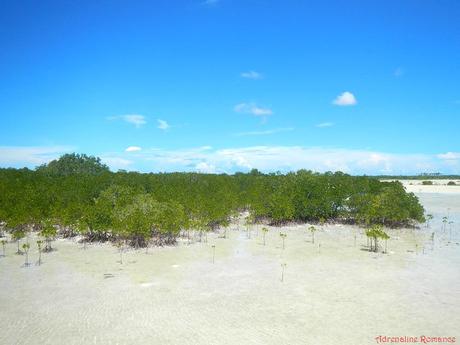
Since we can’t venture into the feeding grounds to see the birds up close, OIWCs expert guides have set up this powerful spotting scope so we can observe the birds from afar. A professional birdwatcher beside me used standard binoculars to witness the birds.
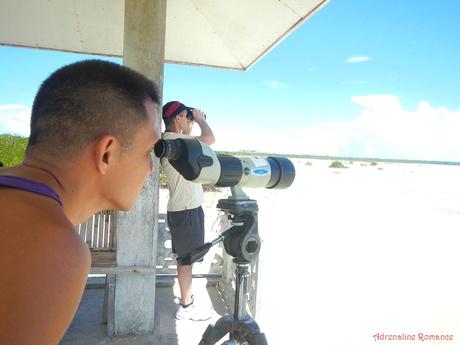
That’s the view from the spotting scope. Can you see the birds? The Olango Island Wildlife Sanctuary houses around 97 species of birds. About half of them are migratory species, and the rest are resident birds.

Asiatic dowitchers systematically survey the feeding ground, poking their long, strong beaks into mudholes to grab hapless victims. These Asiatic dowitchers may have come from Northern Asia and Australia.
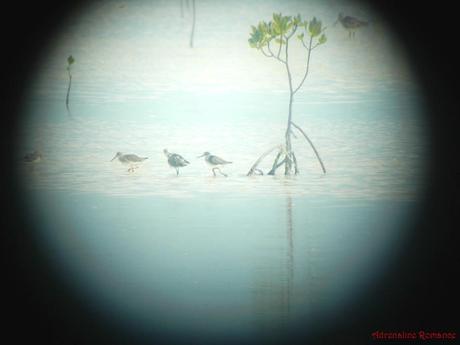
In another corner of the sanctuary, a flock of plovers socialize and hunt for food. Plovers are small wading birds that hunt by sight. Rather than probing the ground with their short beaks, they feed using a run-and-pause technique, waiting for crabs, fish, or worms to emerge from their hiding places.
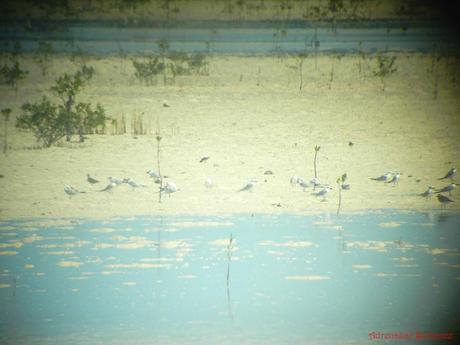
Have you ever wondered how we knew what kinds of birds they are? Well, OIWC guides allow guests to bring a thick guide book that details commonly found birds in the Philippines. The book has detailed drawings, photos, and information of each species.
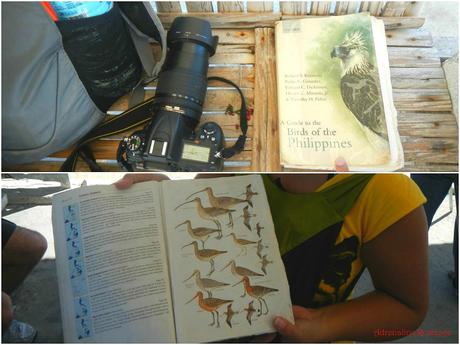
Certified OIWC guides provide useful, interesting, and fascinating information about the birds, mangroves, and marine life as well as the ecosystem of the sanctuary. Knowing the hunting and migratory patterns of birds, the importance of mangroves, the life cycle of fish, and more gives you an insight of just how marvelous, beautiful, complex, and delicate Mother Nature is.
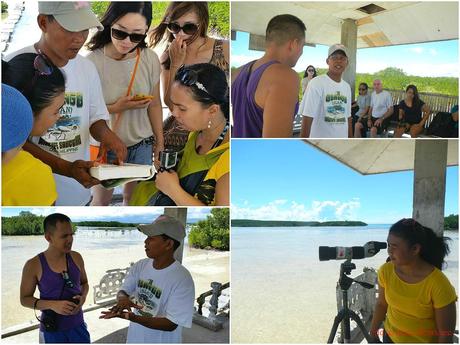
Tired of observing birds? You can just sit down on the bamboo bench in the viewing deck.
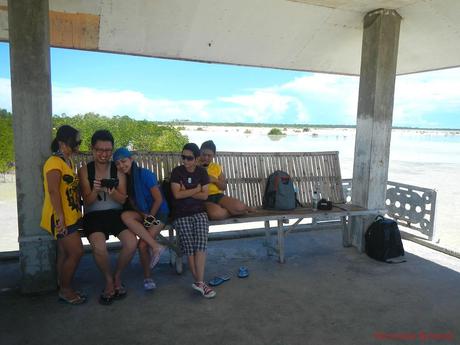
After spending more than 2 well-spent hours spotting different species of birds, it was time to head back home. We stopped for a while in the tent to rest, pack up our things, and wait for our tricycle driver to fetch us.
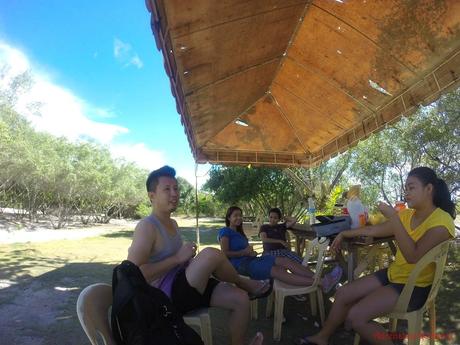
On our way back to the port, we saw large patches of carpet-like grass, only that the grass beds are not mowed by humans! It’s amazing; we’re talking about grass that is as beautifully cut like that in a golf course!
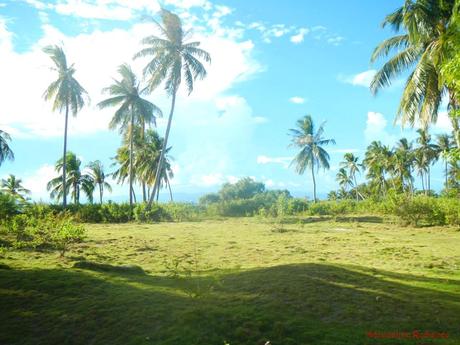
In no time at all, we were heading back to Mactan Island, happy and grateful for the knowledge we gained about migration, birds, mangroves, and shoreline ecosystems.
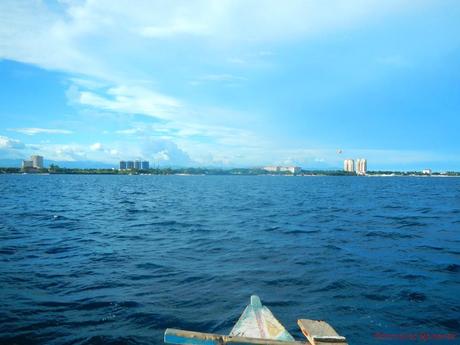
Thank you very much, Jody, Em-em, Jerrold, and Alexa for going with us. We certainly had a lot of fun. But most importantly, we had a glimpse of how our winged friends fit and play an important role in the global biosphere.
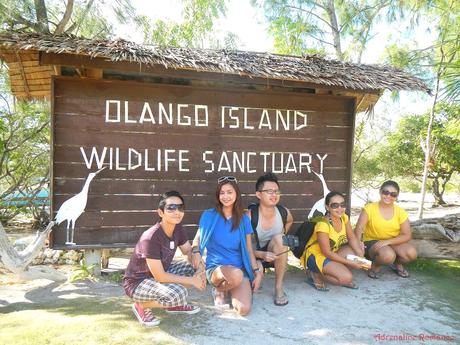
Tips to follow

